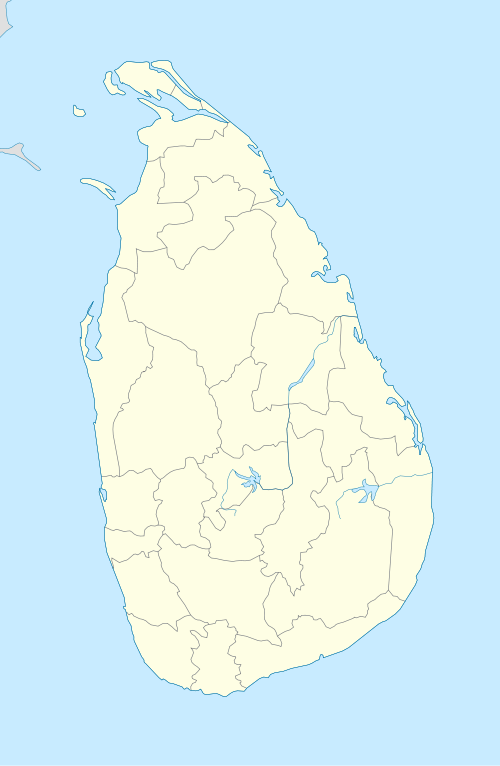Kanniya Hot water spring
| Kanniya Hot water spring | |
|---|---|
 Kanniya Hot Springs | |
 Kanniya Hot water spring Location in Sri Lanka | |
| Name | |
| Proper name | Kanniya Hot Springs |
| Tamil | Tamil: கன்னியா வெந்நீரூற்று |
| Geography | |
| Coordinates | 8°36′16″N 81°16′16″E / 8.60444°N 81.27111°ECoordinates: 8°36′16″N 81°16′16″E / 8.60444°N 81.27111°E |
| Country | Sri Lanka |
| Province | Eastern |
| District | Trincomalee District |
| Location | Kanniya , Trincomalee |
| History and governance | |
| Date built | Unknown; earliest reference in the Ravana period - over 5000 years ago,.[1] |
Kanniya Hot Springs (Sinhalese: කන්නියා උණුදිය ලිං, Tamil: கன்னியா வெந்நீரூற்று) is famous hot well in Sri Lanka from the past. There are seven wells in a square shape. Wells are only 3–4 feet deep and you can clearly see the bottom. The temperature is considerably high but vary from one spring to another. Wells run out of water, when 10-15 buckets of water are taken out.[2]
The pre-history of Kanniya Hot water spring goes back Ravana era and the first written references to the Hot water spring is found in the epic Ramayana. According to the notice board displayed by the Pradeshiya Saba describing this hot water spring is connected with Hindu culture. Most of the Tamils in Sri Lanka doing the religious rites for their lost loved one in this hot water spring. It is believed King Ravana started this religious rites for his mother.
In the ancient time, there was a Buddhist temple complex in this site and the entrance is a part of a Buddhist monastery. Today this site is under the authority of Sri Lankan Archaeological department.
History
King Ravana, pre 5000 BCE
The Ramayana in written form describes how King Ravana and his mother had worshipped Shiva, when the former wanted to remove the temple of Koneswaram when his mother was in ailing health around 5000 BCE. This literature continues that as the king was heaving the rock, Lord Shiva made him drop his sword. Ravanan mother heard that news and thought of unbeatable sorrow. When Ravana returns he found his beloved mother demise was disheartened. To do her mother's rites King Ravana stuck the earth with his sword in several spots and several fountains sprang from these points. The water was hot and this was the beginning of these hot water springs.[3]
Naga Nadu, pre 377 BCE
Mahabharata, the Hindu epic written between 400—100 BCE notes that Hot well is near Gokarna bay, in the middle of the ocean and is the island shrine of Uma's consort Shiva, known in the three worlds and worshiped by all peoples from the subcontinent, including the native tribes Naga, Deva and the Yaksha, the rivers, ocean and mountains.[4] It continues that the Koneshwara Temple and Hot water spring is the next pilgrimage spot for Hindus en route south following Kanyakumari of the early Pandyan kingdom and Tamiraparni island (Kudiramalai) and that worshipers should fast for three days at the temple.[5]
Buddhist Monastery
It is believed that during the historical time, there was a Buddhist temple complex in this site and the entrance of here is a part of a Buddhist monastery. Bhikkhus had used it as a part of their complex.[2] There are large number of remains of Buddhist buildings and ruins scattered over the area, but it seems that most of these historical ruins destroyed during the Sri Lankan Civil War time.
Today
In the LTTE controlled period of this area, the Buddhist connections were suppressed and it was managed by neighboring Mari Amman Kovil.[6]
Now this site is under the authority of Sri Lankan Archaeological department. Sri Lankan Archaeological department replaced the Pradeshiya Saba's noticeboard and mentioned that these wells were probably a part of a pond complex used by Buddhist monks of Velgam Vehera Monastery.[6]
External links
| Wikimedia Commons has media related to Kanniya Hot water spring. |
See also
Notes
- ↑ Notice board put by the Pradeshiya Saba
- 1 2 History of Kanniya hot water wells
- ↑ Sivaratnam, C (1964). An outline of the cultural history and principles of Hinduism (1 ed.). Colombo: Stangard Printers. OCLC 12240260.
Koneswaram temple. Tiru-Kona-malai, sacred mountain of Kona or Koneser, Iswara or Siva. The date of building the original temple is given as 1580 BCE. according to a Tamil poem by Kavi Raja Virothayan translated into English in 1831 by Simon Cassie Chitty...
- ↑ Vyasa. (400 BCE). Mahabharata. Sections LXXXV and LXXXVIII. Book 3. pp. 46-47, 99
- ↑ "Listen as I now recount the isle of Tamraparni, gemmed upon the ocean. The gods underwent austerities there, in a desire to attain greatness. In that region also is the lake of Gokarna. Then one should go to Gokarna, renowned in the three worlds. O Indra among kings! It is in the middle of the ocean and is worshipped by all the worlds. Brahma, the Devas, the rishis, the ascetics, the bhutas (spirits or ghosts), the yakshas, the pishachas, the kinnaras, the great nagas, the siddhas, the charanas, the gandharvas, humans, the pannagas, rivers ocean and mountains worship Uma's consort there". Mahabharata. Volume 3. pp. 46–47, 99
- 1 2 Kanniya Hot Water Wells at Trincomalee – කන්නියා උනු වතුර ලිං